Home
Glenayre
The Office
Training Rooms
The Sites
The
Great Wall
The Ming Tombs
The Summer Palace
The Forbidden City
Tianamen Square
Miscellaneous
Wheat Drying
Silk Street
Hotel
Street Scenes
Other Shopping
Other Fun Stuff
|
|
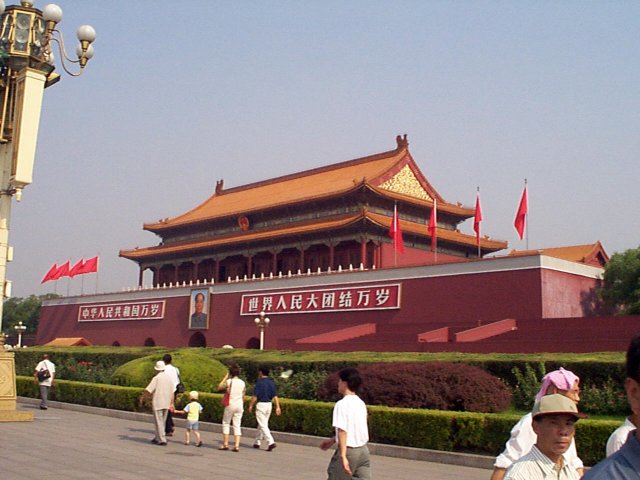
|
| Home of 24 Ming and Qing Dynasty emperors, the Forbidden City
(or Gugong) is a requisite stop for any visitor interested in China's tremendous
past, with which it is forever struggling. Construction of the palace began in 1406.
More than one million workmen were used on the project, and it was not completed
until 1420. Comprised of more than 800 buildings, it covers an area of 72 hectares.
Around the palace is a wall 10 meters high, which in turn is protected by a moat 50
meters wide. The Forbidden City, which has been referred to officially as the Palace
Museum since the 1920s, is the largest and most complete group of palace buildings in
China. The Forbidden City is not to be confused with Tianamen Gate, which is the
massive red edifice bearing Mao Zedong's portrait overlooking Tianamen Square. If you want
to enter the Forbidden City from Tianamen Square, you will first pass through this gate,
whose central archway in imperial times was restricted to the use of the emperor. An
impressive feeling of mass prevails as you enter, but is soon dispelled by the sight of a
gauntlet of vendors selling everything from plastic trinkets to peeks at mummified humans;
cardboard photo backdrops; basketball courts for billeted soldiers; and windows selling
tickets. |
|
|
|
|
|
|
| To the right is a map of the Forbidden City. We are entering through
the Meridian Gate and proceeding to the top of the map. Due to space constraints on this
page, all the rest of the pictures have been "thumbnailed". To see a full
scale picture, just click on it. To return to this page, click the back button on
your browser. |
 |

|
This shot is looking toward the Meridian Gate from inside Tianamen Gate
(Mao Se Tung's fortress). |
| The Gate of Supreme Harmony. As you progress through the pictures,
you will notice that most of the buildings look very similar. I'll explain more as
you go. |

|

|
The Hall of Supreme Harmony. Outside this Hall are two lions.
This one is the male and has his paw on the pulse of the world. The other is female
and has her paw on a cub. |
| This magnificent overhead beam has been restored to its original beauty.
All of these buildings are supported by wood and then lacquered over for
protection. |

|

|
The Palace of Heavenly Purity has a huge courtyard. Notice the
center-line path. This path extends from the backend of the city all the way through
Tianamen Square. During the Dynasties, the Emperor and his carriers were the only
ones allowed on this path. |
| The throne inside the Palace of Heavenly Purity. The number nine received special emphasis in the city
design. The number of houses in the Forbidden City is 9,999, and nails on every door are
arranged in lines of nine nails. This is because ancients regarded nine as the biggest
number, to which only emperors were entitled. Also, since the numeral has the same sound
as "everlasting" in the Chinese language, it
best reflected the wish of emperors that their rule would last forever. |
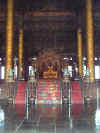
|

|
This picture is of the back door of the Palace of Heavenly Purity.
Gilded no less and very ornate. Tens of thousands of huge stone slabs were used. The
biggest, which lies behind the Hall of Protective harmony (Bao He Dian), weighs 250 tons.
The slab, 16.57 meters long, 3.07 meters wide and 1.7 meters thick, was hauled over a
distance of 50 kilometers from the suburban county of Fangshan to the site by 20,000
laborers at a cost of 5,500 kilograms of silver. The hauling was done in winter on
man-made ice and took 28 days. This slab is located immediately in front of these
doors. |
The throne in the Protective Harmony. |

|

|
The throne in the Hall of Earthly Peace. With all that gold and
glitter around me, I could get into Earthly Peace. |
An outside view of the Hall of Earthly Peace. The
predominant color of the Forbidden City is yellow. Nearly all the houses, for example,
have roofs of yellow glazed tiles. According to ancient Chinese, the universe was made up
of five elements: gold, wood, water, fire and earth, and earth was the most basic of them
all. As a result, yellow, the color of earth, was most extensively used for the emperors,
who were regarded as supreme rulers of humanity. |

|
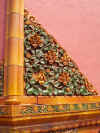
|
The Hall of Earthly Peace has also been called The Ceramic Palace.
This close-up picture of a corner of the wall shows some of the intricate ceramic work. |
| In the living quarter are nine separate housing complexes, where the
emperors and their families lived. North of the living quarter is a small imperial garden.
|
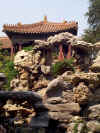
|
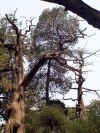
|
A Tang Dynasty poet wrote a line
about the royal palace of his time, which reads: Without seeing the magnificence of the
royal palace, one can never sense the dignity of the emperor.
Magnificent and awe-inspiring, that is how every visitor would describe the Forbidden
City, which served as the seat of imperial power during the Ming and Qing Dynasties
(1368-1911).
|
| In the midst of all this antiquity were signs of modern day life.
Non-Chinese tourists were everywhere as well as Chinese. We rented an audio-tape
tour machine that advised us where we were and information about the site. Cellular
phone abounded. This picture is of ES Hair and a cellular phone call from his
brother advising him he was a brand new Granduncle. Go figure. |
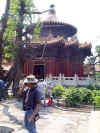
|
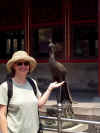
|
As much as the Dragon is the symbol for MAN, the Phoenix is the symbol for
woman. The Ying and the Yung. Here, Dawn tries to get this one to eat out her
hand. |
| Climbing to the top of the hill behind the Forbidden City, we passed some
very old pine trees. These pines were quite different in that the bark had different
colors in different layers. |
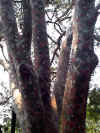
|
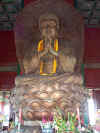
|
At the top of the hill was a small place for prayer. As seen in the
picture, this rather large Buddha took center stage. What you can not see in the
picture are the souvenir stands behind it. |
| A panoramic shot of the Forbidden City. I was told that we had a
good day, weather wise, because one could see the blue sky. Even so, it was still
quite overcast (and this picture was taken about 2PM. |

|
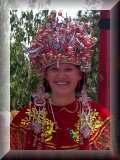
|
Now this one is hard to believe. I have told Dawn that we don't have
Kings and Queens on the Training Department. ES Hair advised her that in China she
could be Empress for a while for 10RMB. Well, of course, she had to do it.
Click on the picture for a pictorial tour of Empress Dawn. |
|
